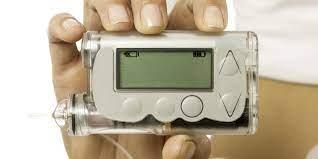"Continuous Glucose Monitoring: A Comprehensive Overview"

In the realm of diabetes management, advancements in technology have brought forth a groundbreaking tool known as Continuous Glucose Monitoring (CGM). CGM systems offer a real-time view of glucose levels, empowering individuals with diabetes to make informed decisions about their treatment regimen and lifestyle. This technology marks a significant shift from traditional intermittent blood glucose monitoring methods, providing continuous insights and enhancing overall diabetes care.
Understanding Continuous Glucose Monitoring (CGM)
Continuous Glucose Monitoring involves the use of a small sensor inserted under the skin, typically on the abdomen or arm. This sensor measures glucose levels in the interstitial fluid, providing data points throughout the day and night. The information collected is transmitted wirelessly to a receiver or smartphone, where users can view their glucose trends, set alerts for high or low glucose levels, and track patterns over time.
Benefits of CGM Systems
-
Real-Time Insights: Unlike traditional fingerstick testing, CGM systems offer continuous monitoring, providing a more comprehensive understanding of glucose fluctuations. This real-time data enables users to respond promptly to highs and lows, reducing the risk of complications.
-
Improved Glycemic Control: With access to continuous glucose data, individuals can adjust their insulin dosages, dietary choices, and physical activity levels more effectively, leading to better glycemic control and potentially lowering HbA1c levels.
-
Enhanced Quality of Life: CGM technology minimizes the need for frequent finger pricks, offering a less invasive and more convenient method for monitoring glucose levels. Continuous Glucose Monitoring It also provides peace of mind, particularly for individuals with nocturnal hypoglycemia or those prone to severe glucose fluctuations.
-
Insightful Data Analysis: CGM systems generate comprehensive reports and trend analysis, allowing healthcare providers to tailor treatment plans based on individual patterns and behavior. This personalized approach can optimize diabetes management and facilitate more meaningful discussions between patients and clinicians.
Evolution of CGM Technology
Over the years, continuous glucose monitoring technology has evolved significantly, with advancements aimed at improving accuracy, reliability, and user experience. Key developments include:
-
Sensor Accuracy: Manufacturers have made significant strides in enhancing sensor accuracy, reducing instances of false alarms and improving overall reliability.
-
Integration with Insulin Pumps: Some CGM systems now offer integration with insulin pumps, creating a closed-loop system that can automatically adjust insulin delivery based on real-time glucose readings.
-
Interoperability and Connectivity: CGM devices increasingly feature seamless integration with smartphones and other digital platforms, allowing for remote monitoring and data sharing with healthcare providers and caregivers.
-
Predictive Algorithms: Advanced algorithms incorporated into CGM systems can predict future glucose trends, providing proactive alerts to help users prevent hypoglycemia or hyperglycemia episodes.
Challenges and Considerations
Despite its numerous benefits, Continuous Glucose Monitoring also presents certain challenges and considerations:
-
Cost: CGM systems can be expensive, and not all insurance plans cover the costs associated with sensors and transmitters. Affordability remains a barrier for many individuals, limiting access to this life-changing technology.
-
Technical Issues: Users may encounter technical issues such as sensor calibration errors, signal loss, or skin irritation at the insertion site. Proper training and troubleshooting guidance are essential to mitigate these challenges.
-
Data Interpretation: Interpreting CGM data requires a degree of knowledge and understanding of diabetes management principles. Education and support from healthcare providers are crucial to ensure users can effectively utilize the information provided by the device.
- Art
- Causes
- Crafts
- Dance
- Drinks
- Film
- Fitness
- Food
- Juegos
- Gardening
- Health
- Home
- Literature
- Music
- Networking
- Other
- Party
- Religion
- Shopping
- Sports
- Theater
- Wellness
- IT, Cloud, Software and Technology


